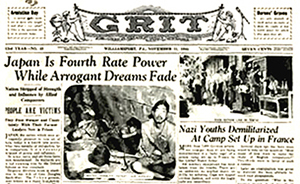During the late 1940s, I recall seeing young men in downtown Johnson City selling a weekly national newspaper with the curious title “Grit.” These salesmen stood at busy locations, typically the corner of Spring and E. Main streets and along the front of the old City Bus Terminal at Buffalo.

A Grit newspaper in 1932 consisted of a regular size newspaper and 8.5 x 11.5 “Story Section” insert. The 28-page tabloid contained seven mostly “to be continued” stories aimed at different ages and both genders; two full page cartoon strips, “Bringing Up Father” and “The Bungle Family;” a column titled “Poems – New and Old Favorites;” and numerous ads. The successful Williamsport, PA newspaper recruited boys from across the country to peddle its merchandize in the bustling business districts of yesteryear.
An ad from the same 1932 Grit newspaper reads: “Boys – Sell Grit – Earn Cash, also a watch, rifle, glove, wagon, knife, scooter and many more free prizes. Fellows, you can have a paying business of your own by selling Grit on Saturdays. Over 19,000 boys are now making money and winning prizes. Besides their free prizes, many of them earn $1 to $5 every Saturday.”
A second ad from the news publication further stated: “Grit is easy to sell. It contains the news of the world, 150 pictures, comics, sports, a wonderful Story Section and many other intensely interesting features that delight the entire family. We give you a newsbag free.” A notice inside the paper was aimed at obtaining steady customers: “Send us $2 and your full address and Grit, together with the Story Section, will be sent to your post office or delivered by your mail carrier 52 weeks without further difficulty.”
In order to recruit young street vendors, the business published small 12-page comic books, such as one titled “Grit Will Help You As Nothing Else Can!” The storyline involves a young man receiving a leadership award from the local Boys Club. His friend Joe, envious of the lad’s recognition, decides to improve his skills by becoming a Grit paperboy. The results are quite predictable. After becoming a successful Grit salesman, Joe likewise receives a leadership award from the club and earns enough money to go to camp.
The booklet mentions six distinguished men who acknowledged that their Grit selling experience helped them along the road to success. The most recognizable celebrity was singing cowboy star, Gene Autry. Each Grit “salesboy” wore a hexagon shaped bronze-colored pin on his shirt to identify him as being an “Authorized Salesman.” After selling papers on the street for a week, carriers filled out a weekly sales report and returned it to the company, along with cardboard coin cards containing money collected that week.
The brainchild behind Grit was German immigrant Dietrick Lamade, who began publishing it in 1882. The entrepreneur was not satisfied with just selling papers; he wanted his product to brighten readers' lives with news focused on happiness, optimism, peace, cheer and contentment. Conspicuously absent was pessimistic and negative reporting.
Lamade’s recruits were said to have learned valuable lessons in honesty, integrity and perseverance. Grit sales figures went from 100,000 in 1900 to 300,000 in 1916. Grit is still around today but is now published as a magazine focusing on contemporary country life.
The young eager males hoping to get rich by selling Grit newspapers at downtown street corners of heavy pedestrian and automobile traffic flow have long since vanished from the American scene.
